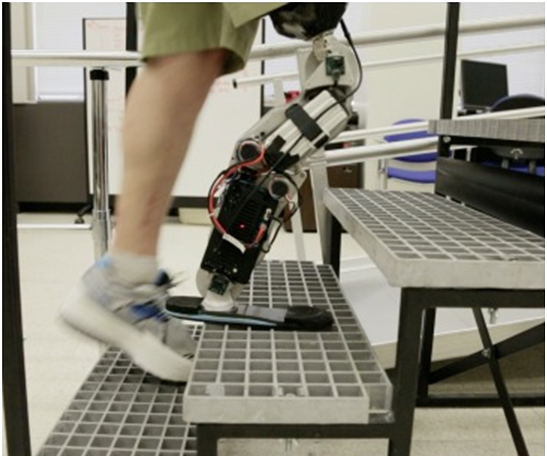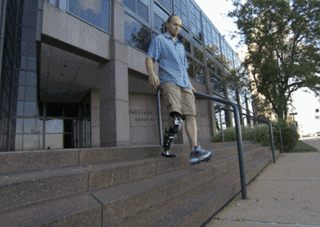Climbing 103 floors with a neural-controlled bionic leg
November 12, 2012

RIC unveils world’s first neural-controlled bionic leg at fourth annual skyrise Chicago event (credit: RIC)
In the world’s tallest indoor stair climb event, Rehabilitation Institute of Chicago (RIC) research subject Zac Vawter climbed 103 floors of the Chicago Willis Tower Nov. 4 using the first “Bionic Leg,” a neural-controlled prosthetic leg driven by his own thoughts
RIC’s Center for Bionic Medicine pioneered the Targeted Muscle Reinnervation (TMR) technique, which allows amputees to have more natural control of prosthetic devices.
What makes it “bionic” is that it interacts with Zak. When he pushes on the device to stand up, the device reads his intent and pushes back on him, propelling him up.
“One of the biggest difference for me is being able to take stairs step-over-step like everyone else,” said Vawter. “With my standard prosthesis, I have to take every step with my good foot first and sort of lift or drag the prosthetic leg up. With the bionic leg, it’s simple, I take stairs like I used to, and can even take two at a time.”

With the bionic leg, “I go leg over leg,” says Vawter. “The bionic leg listens to the various signals from my nerves and responds in a much more natural way.” (Credit: NBC)
SkyRise Chicago is a climb and fundraising event that raises funds for RIC’s world-class clinical care and innovative research.
Nearly 3,000 participants climb 103 flights of stairs of Willis Tower, or hand cycle the equivalent with specially calibrated hand cycles, or “virtually” participate through fundraising alone to raise funds for RIC.
“There are approximately 600,000 individuals with lower limb amputation in the United States, and we are hopeful that this neural-controlled technology will allow for more ability and more long-term independence,“ said Levi Hargrove, PhD, Director of the Neural Engineering for Prosthetics & Orthotics Lab within RIC’s Center for Bionic Medicine.
This work is a result of a grant from The Department of Defense Army’s Telemedicine and Advanced Technology Research Center (TATRC), aimed at improving the control of advanced robotic leg prostheses by adding neural information to the control system. This work is a collaborative effort lead by RIC’s Center for Bionic Medicine, and including the University of New Brunswick, Vanderbilt University, MIT, and URI.